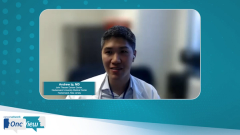
Future Outlook of Mantle Cell Lymphoma Treatment
Andre H. Goy, MD, and Andrew Ip, MD, offer insights on the future of mantle cell lymphoma treatment.
Episodes in this series

Transcript:
Andre H. Goy, MD: In the frontline setting, that’s where the paradigm is going to shift even more, in that the ability to do NGS [next-generation sequencing]—now we do this routinely—allows you to detect abnormalities such as TP53 mutation and others, particularly complex karyotype in the frontline setting. About one-third of these patients should either be on a clinical trial, or in our institution and academic center we treat them with a nonchemotherapy option. If they’re younger, we give them hyper-CVAD [cyclophosphamide, vincristine sulfate, doxorubicin hydrochloride, and dexamethasone], particularly if they had only 4 cycles, if they had an aggressive presentation, or are back if they’re older. And so far, results are very promising. The last piece is that the real end point in mantle cell lymphoma treatment is becoming MRD [measurable residual disease], and we all need to work together to make sure that we define finite therapy MRD negative and be able to stop and continue to move forward with innovation and improve our patients’ outcomes.
Andrew Ip, MD: I think that you answered this last question, but can you explain to the audience any final thoughts on, obviously you mentioned MRD, but the bispecific T-cell engagers. You mentioned glofitamab. There are obviously a couple of others. There are going to be approvals for mantle cell lymphoma treatment that we’ll be seeing for some of these products. Explain to the audience where you see that’s going to be played out to—the relapse setting, maybe even frontline studies, but more for the standard of care approaches. You can also talk about anti-ROR1 in your final thoughts here.
Andre H. Goy, MD: I’ll start with anti-ROR1 because we don’t have as much experience. ROR1 is expressed on embryonic cells and cancer cells but not on normal cells, so that helps the toxicity profile. It has shown activity across the board in a number of lymphomas and CLL [chronic lymphocytic leukemia], and it’s currently being combined with other small molecules. But you raised a question of the bispecific. I think this is really important because the bispecific is a way to do a T-cell engaging therapy. We all believe, and I know you believe strongly that the future is small molecule and T-cell engaging therapy across the board. T-cell engaging therapy consists of checkpoint inhibitors, which has not been obvious in lymphoma outside of primary mediastinal and Hodgkin, or it’s CAR [chimeric antigen receptor] T-cell or it’s bispecific. The bispecific is a small molecule that creates a bridge to re-engage the T-cells against the target.
There are a number of them, as you mentioned. CD19, CD20, and glofitamab have shown remarkable response rates, are very durable, even stopping treatment after a year. And as you mentioned, there are several others that also have shown remarkable activity in the relapsed/refractory setting. Where might they fit? I think a patient that might not be a candidate for CAR T-cell might be an option because we don’t know if they cure anyone yet. But they could also be an interesting approach as a consolidation after induction with a small molecule, and then as a consolidation to prevent a recurrence, which is also one of the next frontiers in treating these patients. And when it gets approved, we will not have data ready, obviously, to look at whether CAR T-cell therapy is better than bispecifics.
There’s the concern when you do use bispecific too early vs CAR T-cell therapy that you might also potentially deplete more T cells and expose the patient to anti-CD19 cell therapy that might compromise the benefit of CAR T-cell therapy. Most of the activity that has been confirmed and proven is that in patients who failed CAR T-cell, they can respond to bispecifics and sometimes very durable in large cell lymphoma. But also, it has been the case in mantle cell to a lesser degree. And rather than maybe delaying the CAR T-cell therapy that we just reviewed, which can have 49% of the patients doing well at 3 years, I think many of these patients are likely cured. As we all work together, we will continue to answer what’s the best sequence of care, which is very exciting.
Transcript edited for clarity.
Newsletter
Stay up to date on recent advances in the multidisciplinary approach to cancer.



























































































